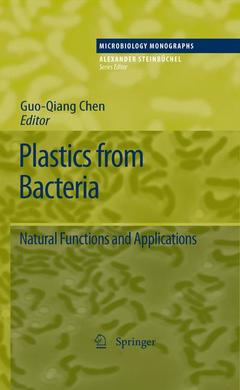Description
Plastics from Bacteria, 2010
Natural Functions and Applications
Microbiology Monographs Series, Vol. 14
Coordinator: Chen George Guo-Qiang
Language: English
Subjects for Plastics from Bacteria:
Plastics from Bacteria
Publication date: 05-2012
450 p. · 15.5x23.5 cm · Paperback
Publication date: 05-2012
450 p. · 15.5x23.5 cm · Paperback
Plastics from bacteria: natural functions and applications (series: microbiology monographs) POD
Publication date: 02-2010
Support: Print on demand
Publication date: 02-2010
Support: Print on demand
Description
/li>Contents
/li>Comment
/li>
Due to the possibility that petroleum supplies will be exhausted in the next decades to come, more and more attention has been paid to the production of bacterial pl- tics including polyhydroxyalkanoates (PHA), polylactic acid (PLA), poly(butylene succinate) (PBS), biopolyethylene (PE), poly(trimethylene terephthalate) (PTT), and poly(p-phenylene) (PPP). These are well-studied polymers containing at least one monomer synthesized via bacterial transformation. Among them, PHA, PLA and PBS are well known for their biodegradability, whereas PE, PTT and PPP are probably less biodegradable or are less studied in terms of their biodegradability. Over the past years, their properties and appli- tions have been studied in detail and products have been developed. Physical and chemical modifications to reduce their cost or to improve their properties have been conducted. PHA is the only biopolyester family completely synthesized by biological means. They have been investigated by microbiologists, molecular biologists, b- chemists, chemical engineers, chemists, polymer experts, and medical researchers for many years. PHA applications as bioplastics, fine chemicals, implant biomate- als, medicines, and biofuels have been developed. Companies have been est- lished for or involved in PHA related R&D as well as large scale production. It has become clear that PHA and its related technologies form an industrial value chain in fermentation, materials, feeds, and energy to medical fields.
of Bacterial Plastics PHA, PLA, PBS, PE, PTT, and PPP.- Plastics Completely Synthesized by Bacteria: Polyhydroxyalkanoates.- Natural Functions of Bacterial Polyhydroxyalkanoates.- Towards Systems Metabolic Engineering of PHA Producers.- Microbial PHA Production from Waste Raw Materials.- Industrial Production of PHA.- Unusual PHA Biosynthesis.- Metabolic Engineering of Plants for the Synthesis of Polyhydroxyalkanaotes.- Biosynthesis of Medium-Chain-Length Poly[(R)-3-hydroxyalkanoates].- Nodax™ Class PHA Copolymers: Their Properties and Applications.- Manufacturing of PHA as Fibers.- Degradation of Natural and Artificial Poly[(R)-3-hydroxyalkanoate]s: From Biodegradation to Hydrolysis.- Microbial Lactic Acid, Its Polymer Poly(lactic acid), and Their Industrial Applications.- Microbial Succinic Acid, Its Polymer Poly(butylene succinate), and Applications.- Microbial Ethanol, Its Polymer Polyethylene, and Applications.- Microbial 1,3-Propanediol, Its Copolymerization with Terephthalate, and Applications.- Microbial cis-3,5-Cyclohexadiene-1,2-diol, Its Polymer Poly(p-phenylene), and Applications.
Includes supplementary material: sn.pub/extras
© 2024 LAVOISIER S.A.S.




